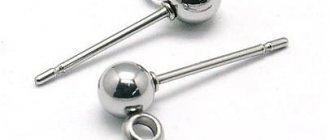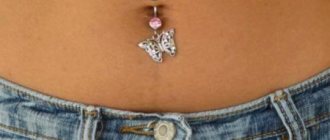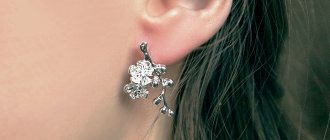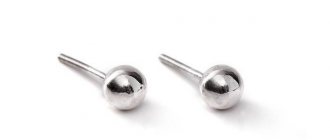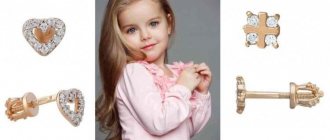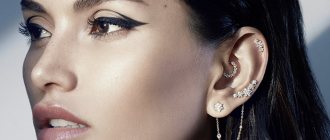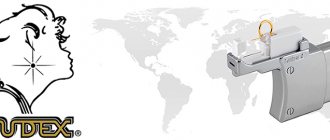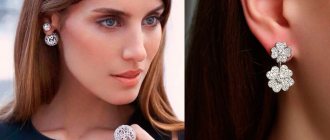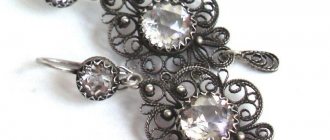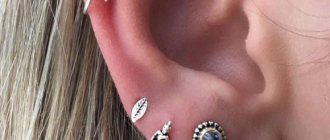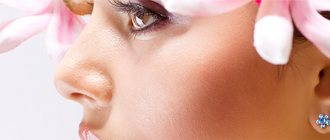How long should you wear your first earrings?
It is recommended to wear the first medical earrings for 1-2 months. It is not recommended to remove stud earrings after a piercing or ahead of time for several reasons:
- studs fix the correct direction of the puncture, eliminating its displacement or deformation;
- If you follow the simplest rules of hygiene, infections will not get into the wound;
- painless tightening of the damaged part of the lobe occurs around the stud guide.
The indicated period is averaged and is due to a number of objective and subjective reasons.
Depending on age, gender, general health and epidermis, you can remove medical earrings from your ears earlier or later than expected. For those who make numerous piercings of the earlobe, around the perimeter or inside the auricle (Daith, Industrial, Tragus and other types of piercing), the period of wearing medical earrings can be significantly extended.
View all stud earrings (go to the SUNLIGHT catalogue)
If you are sure that the healing of the standard puncture was successful, there is no pain or other unpleasant sensations, you can remove the first stud earrings yourself. In case of a complex piercing, it is better to contact a specialist.
gun stud earrings
here is the article
On the needle
January 24, 2011, 11:15
In order not to spoil things: we will talk about piercings. No, it’s not about the fact that “people around me don’t understand me” - you are an adult, weigh all the pros and cons in advance, compare the concentration of boorish aunties and patriotic grandmothers with the thickness of your nerves at once. I'm talking about something else: earrings in my ears. This, as you understand, is the most traditional type of piercing.
So here it is. Moms! You, presumably, have never gone to a professional piercing salon to pierce the ears of your one-year-old child. That's right, why go to this dubious den with drunk men hung with ironclads? Moreover, these sober, decisive uncles and aunts will turn you away from there. Do you know why? Because for piercers (not dubious cosmetologists and hairdressers in this regard, but people with appropriate education and practice) this is the main type of work, and none of them needs low-quality piercings in their portfolio. It's not even a matter of causing pain - that's not so bad. You will not find a “gun” in any piercing salon. They run away from them like the devil from incense: they cannot be sterilized. Hepatitis in a one-year-old child is more serious than pain, isn’t it?
If it’s gone with illnesses, then let’s move on to healing. Due to its shape, a standard pistol “nail” is like a container for dirt. Surgical steel? Surprise, surprise: this is not piercing and implantation steel, it is scalpel steel. That is, something that will not remain in the body for months, releasing toxic nickel into the blood. Are black dots on punctures familiar?
Have you been told to rotate the jewelry in the puncture and rinse with alcohol (vodka)? Prepare to take several months to heal your ears. You absolutely cannot disturb the decoration if you want normal healing and no inflammation. Now let me see how you will explain to a one-year-old baby that you can’t touch his ears, even if your hands are washed of porridge and drool!
Shall we put gold or silver earrings? Have you ever met girls who are painfully sensitive to these metals? Ask how old they were when they had their ears pierced. You will be surprised. You also can’t put precious metals in your ears right away. Remember physics and chemistry: in gold 585 and silver 525 gold and silver are 58.5% and 52.5%, respectively. The rest is impurities. At the same time, remember the word “diffusion”.
Still vague? Then the most important aesthetic moment for such mothers. No piercer will pierce the ears of a small child. This time remember biology and periods of intense growth. The ears are growing too. In 90% of cases, the asymmetry of the punctures will be clearly visible by school time.
It's not necessary. And now - as it should. Punctures should be done (either for you or for your grown-up child) by a person wearing gloves on a pre-sterilized area of skin with a disposable needle, opened in front of you, according to preliminary markings made with a special marker. It doesn't hurt more than a gun. Jewelry made of titanium, implantium or bioplast should be inserted into the piercing. The piercer will recommend a form that will facilitate healing: there is a choice. Do not twist, tug or touch the jewelry; wash it carefully with non-alcohol-containing products, for example, the familiar chlorhexidine. This is the only way you can be guaranteed to get what you wanted: even, well-healed and problem-free punctures for beautiful gold heirloom earrings of complex shape, which you will wear a month later. Love your girls, don't spoil their health and appearance. Good luck!
From here
How to remove stud earrings correctly
If the puncture site and the protruding parts of the studs are periodically treated with a disinfectant, removing medical stud earrings from your ears will not be difficult.
- Hands are thoroughly washed with soap and treated with alcohol, a weak solution of hydrogen peroxide or any antiseptic.
- Using a cotton swab or disk moistened with any of the above products, wipe the earlobe on both sides and the protruding parts of the stud.
- The earring is carefully turned in one direction and the earlobe and stud are wiped again with an antiseptic.
- The latch/lock is unfastened or removed.
- Slowly, with twisting if necessary, the earring is removed from the ear.
- Again, the earlobe is treated with an antiseptic on both sides, including the puncture site.
If the wound has healed completely and there are no painful or other unpleasant sensations, you can put on new earrings. In case of burning, tingling at the puncture site, or presence of bloody or other discharge, you should consult a doctor to rule out possible inflammation.
Do not try to suddenly remove stud earrings after piercing your ears with a gun. In addition to pain, it can damage the epidermis and cause bleeding or inflammation.
How to unfasten a stud earring
Knowing the type of clasp, opening stud earrings is quite simple:
- the metal threaded fastener is carefully unscrewed;
- the silicone retainer is smoothly removed from the stud guide;
- Unlocking the classic lock allows you to easily unfasten the stud earring after piercing.
When choosing medical earrings, pay attention not only to comfort during use, but also to the type of fixation. The lock is the most popular and comfortable type of fastener. It fixes the earrings at a certain level and is easy to unfasten.
studs for ear piercing
INTERESTING ARTICLE here is a link to the source https://www.service-beauty.ru/article04.html
For those who decide to pierce the ears of babies, it’s interesting to read, for general development...
I want to pierce my princess...
It is necessary to take into account the fact that a person, and especially the “little man”, performs some actions and movements arbitrarily, unconsciously, and, therefore, one should be prepared for all kinds of “surprises”. That is, when dressing, playing, or going to bed, the child will not always remember the presence of a new object in the ears. ATTENTION! Official medicine does not recommend piercing ears until the age of three. At the same time, recent studies show that punctures of the earlobes later than 11 years of age increase the risk of developing keloid scars at the puncture site. In addition, doctors warn: on the earlobe there are many points associated with the eyes, teeth, tongue, facial muscles and inner ear. Therefore, according to doctors, a puncture is not so safe. An unsuccessful attempt can cause painful irritation of the point and the organ associated with it.
In turn, child psychologists insist that it is better to insert earrings before the age of 1.5 years, when the child does not yet experience fear and quickly forgets about the pain. When my daughter grows up, it will be more difficult - whims, hysterics, tears. And then you will have to wait until the child consciously wants this, knowing and understanding that it will hurt.
Ear piercing for children is contraindicated:
*
if the child suffers from serious chronic diseases
* there is a predisposition to keloids
* wounds heal poorly
* if the child has recently (at least 2 weeks) suffered from an infectious disease
* if the child feels unwell
*severely weakened immune system
But in any case, you should be prepared for possible complications. After all, even the most sterile piercing can cause not only inflammation, but also the formation of granulomas - skin growths.
To get rid of them, granulomas are first irradiated and then surgically removed.
But even such serious treatment does not always help. Therefore, before piercing a child’s ears, you should take him to a dermatologist - in some children, the skin is prone to the formation of keloid scars. If the risk is high, it is better not to damage your ears, but to wear ear clips. It is not recommended to pierce the ears of children who are very scared, agitated, resisting or crying.
Try coming another time. In children who are healthy and behave calmly and confidently, both the puncture itself and subsequent healing, as experience shows, proceed without any problems. So, if, taking into account all of the above, you and your child are ready for ear piercing, then it’s time to decide:
Where to get the piercing done? What method (tool)? What earrings should I use? How to eliminate the risk of infection? How to care for your ears after piercing?
Now in almost every beauty salon you can quickly, safely and almost painlessly pierce the ears of a child of any age. This procedure is quite accessible. Immediately put on the selected earrings - studs, or earrings with a bow (everything is sterile, stored in special containers). You can also contact specialized piercing salons, where qualified craftsmen will perform the procedure using disposable needles. The most common method of earlobe piercing is using an “earlobe piercing gun.” It is easy to use and safe if precautions are taken.
The puncture is carried out with disposable earrings - needles by “shooting” the earlobe.
Thus, the procedure is completed quickly and the earring - needle remains in the puncture. Which is more convenient, as it eliminates further painful manipulations with jewelry. The disadvantages of this method include the fact that a reusable tool is used.
And although the “gun” is disinfected before each use, complete sterilization is impossible due to its design features. Another “minus” is that during operation the instrument produces a characteristic sound. And a child who is in a tense state can make an involuntary movement and the location and direction of the puncture will change accordingly.
For ear piercing, earring needles are also used, which are removed from individual sterile packaging in your presence. The earring needles used in the pistol are made from high quality surgical steel and can be supplied in a gold plated version or inlaid with precious stones.
It is not recommended to insert gold jewelry immediately after the piercing procedure! Gold jewelry is typically made from 585 (14 karat) and 750 (18 karat) gold. The sample shows how many parts of gold and alloy (impurities) are per 1000 units of mass. For example, 750-carat gold is 75% pure gold and 25% alloys. As for the 585 sample, everything is much scarier and more dangerous. Such products contain only 58.5% gold and 41.5% impurities, which can cause an allergic reaction.
It is strictly forbidden to wear silver jewelry in the primary piercing, because... silver actively oxidizes upon contact with human blood and lymph, as well as upon contact with products that are used to treat punctures during the healing period. The resulting oxide interferes with healing and leads to the appearance of black spots at the puncture sites.
A child's ears should be pierced in a surgical room under sterile conditions.
The operation must be carried out by a suitably qualified specialist. Piercing needles and earring needles are used only in individual packaging. The tool must be properly processed. Don’t be shy to ask about the sterility of instruments!
During the healing period (2-3 weeks), the puncture and jewelry must be processed 3-4 times a day, without turning the jewelry. At night you can lubricate with antiseptic ointments. In cases of heavy purulent discharge from the wound, bleeding, significant swelling and other atypical reactions of the body, you should seek help from a specialist and not self-medicate.
How to remove earrings for a child after being pierced with a gun
Medical stud earrings for children are removed in the same way as for adults. It is important to initially choose lighter and more comfortable models of studs with a convenient, easily removable clasp. Since the baby may touch his ears when feeling discomfort, it is necessary to choose a durable and securely blocking clasp.
If, after the required period of time after the puncture, the wound has healed, no discharge or inflammation is noticed, the mother can remove the child’s medical stud earrings on her own. In other cases, it is better to contact a specialist.
Gold earrings with cubic zirconia (go to the SUNLIGHT catalogue)

